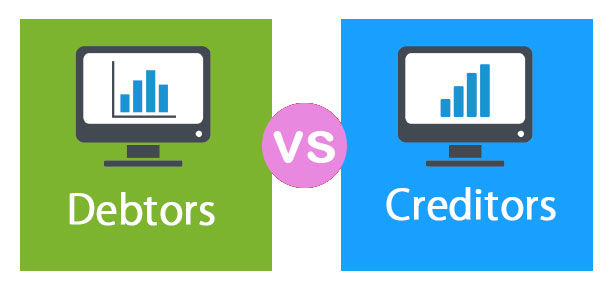6 differences between Debtor and Creditor
- Irvine Bookkeeping

- Nov 5, 2019
- 4 min read
Updated: Oct 7

In finance, the key difference between a debtor and a creditor lies in who owes and who is owed.
A debtor is a person or business that borrows money or receives goods or services on credit and must repay the amount due.
A creditor is the lender or supplier who provides money, credit, or goods expecting repayment, often with interest.
This relationship forms the basis of financial transactions — debtors are assets in accounting, while creditors are liabilities.
Understanding these roles helps businesses manage debt, maintain cash flow, and support financial stability.
Introduction to Financial Relationships
A financial relationship exists whenever one party provides money, goods, or services to another with the expectation of future repayment. This relationship enables access to capital, supports growth, and keeps the economy active.
In this system, creditors lend or supply resources, while debtors borrow or purchase on credit. Managing this exchange effectively ensures steady cash flow and helps both individuals and businesses meet their financial obligations. Understanding how debtors and creditors interact is essential for maintaining financial stability and responsible debt management.

What is a Creditor?
Creditors play an essential role in the financial system by providing funds, goods, or services to others with the expectation of future repayment. They enable businesses to operate smoothly, support cash flow, and drive economic growth. Depending on the nature of the transaction, creditors can take different forms — from individuals to large financial institutions.
Creditors can be used to describe a person who gives a loan to any other person and in return, he supposes to get interest on the loan he is giving.
Types of Creditors:
By Entity
Personal creditors: Individuals such as friends, family members, or private lenders who lend money personally.
Real creditors: Financial institutions like banks, credit unions, or lending companies that provide formal loans or credit services.
By Transaction Type
Loan creditors: Provide funds to borrowers and charge interest over time.
Trade creditors: Supply goods or services on credit, allowing delayed payment.
Secured creditors: Require collateral before lending, such as mortgage lenders.
Unsecured creditors: Offer credit without collateral, like credit card companies.
Therefore, a creditor could be a person as well as an institution.
The term creditor could be used for short-term loans, long-term bonds, and mortgage loans. Creditors are mentioned as a liability in the balance sheet of an organization.
You may also want to read:
What is a Debtor?
A debtor can be defined as the individual or firm who receives the benefit without paying for it in terms of money or money’s worth immediately but is liable to pay the money back in due course of time. The debtors are shown as an asset in the balance sheet.
Role of Debtors in Business Accounting
Debtors play a key role in maintaining a company’s working capital and cash flow. When a business sells goods or services on credit, the amount owed by customers becomes accounts receivable, recorded as a current asset in the balance sheet. These receivables represent future income and help track how much money the business expects to collect. Efficient debtor management ensures timely payments, reduces bad debts, and supports overall financial stability.
Major Differences Between Debtors and Creditors
Here is a table of the top 6 differences between a creditor and a debtor:

Real-World Examples of Debtors and Creditors
The creditor–debtor relationship appears in many everyday transactions.For example, when a business buys inventory from a supplier on credit, the supplier is the creditor and the business is the debtor until payment is made.Similarly, when an individual borrows money from a bank to buy a home or car, the bank acts as the creditor, and the borrower becomes the debtor responsible for repayments.
These relationships are vital for maintaining cash flow and working capital. By tracking how quickly debtors pay and when payments are due to creditors, businesses can manage liquidity effectively and ensure financial stability.
Why Managing Debtors and Creditors Matters for Your Business
Successfully managing the creditor and debtor dynamic requires proactive communication and careful attention to financial obligations. Debtors should prioritize making payments on time to protect their credit score and avoid additional costs from late payment fees. Creditors, meanwhile, should clearly communicate loan terms, including interest rates and repayment schedules, to set clear expectations.
When debtors encounter financial difficulties, creditors may offer solutions such as temporary payment plans or hardship programs to help them meet their obligations. By working together and maintaining transparency, creditors and debtors can overcome challenges, ensure fair treatment, and contribute to a stable financial environment where both parties benefit from their financial relationship.
How Irvine Bookkeeping Can Help
At Irvine Bookkeeping, we help businesses manage their debtors and creditors efficiently to keep cash flow healthy and finances organized.
Our team tracks invoices, payments, and outstanding balances, ensuring that you get paid on time and pay suppliers accurately.
We also provide insights into your accounts receivable and payable, helping you identify risks early and make informed financial decisions.
Let IrvineBookkeeping help you send your invoices and track the payments for you!
If you need advice or services on any aspect of bookkeeping, accounting, and tax, our specialists are ready to help. Get in touch with us for a free quote.
#Debtors #Creditors #AccountsReceivable #createinvoices #liability #bookkeeping #receipt #payment #invoice #loan #IrvineBookkeeping







Comments